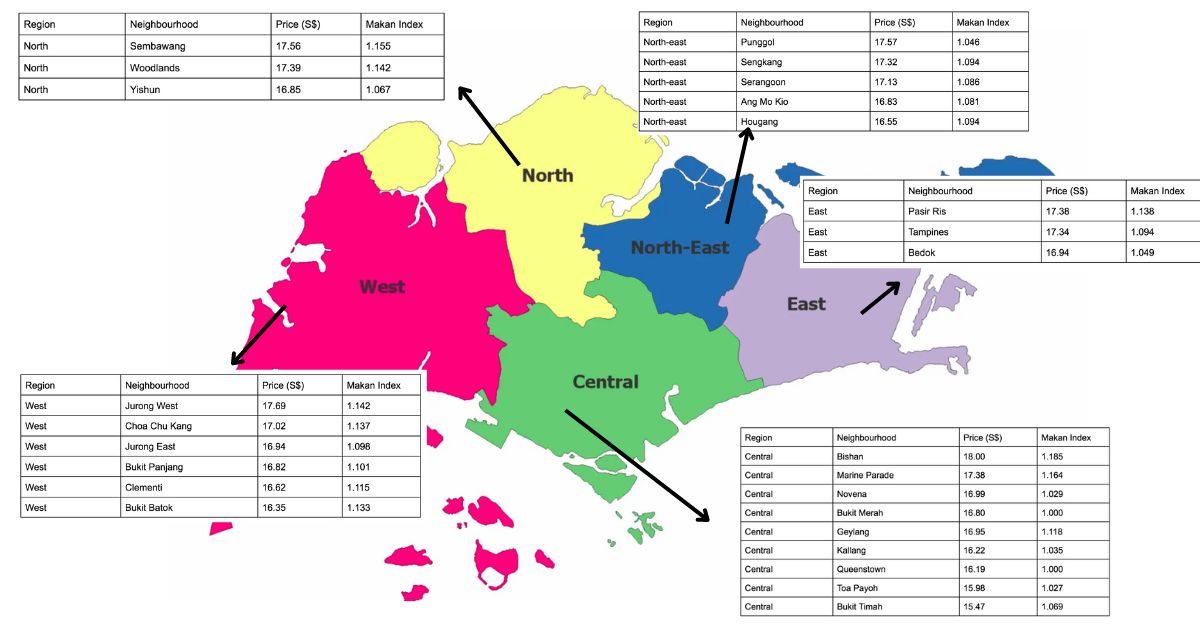The cost of living has been rising in Singapore, and with it, the cost of dining out. It’s become enough of a problem that the government had to address it with the upcoming HDB budget meal scheme that will be implemented by 2026.
If you can’t afford to wait till then, a study by researchers from the Institute of Policy Studies (IPS) revealed the cheapest and most expensive places in Singapore to eat, so you can hopefully use the information to save some money.
Here’s all you need to know.
Price Rise?
Titled The Cost of Eating Out: Findings from the Makan Index 2.0, the study was conducted by IPS researchers Teo Kay Key, Hanniel Lim, and Mindy Chong and released on 13 March.
The study found that most food stall owners in hawker centres, food courts and kopitiams did not increase their prices between late 2022 and early 2023, despite the rising stall costs.
The minority that did so increased their prices by a small margin of more than 30 cents for each item sold, to prevent driving customers away. Overall, the price increase for most food items surveyed did not exceed 10 cents.
Somehow, ice Milo had the most significant price increase—the price of the drink rose by 12 cents on average, or by 7%. 23 out of 55 stalls surveyed increased its price. If you’re on a budget, maybe getting a simple kopi with your meal is better now.
For main dishes, sliced fish soup with rice went up 5%, or about 28 cents, while fishball noodles had a price hike of around 19 cents, also 5%. However, less than half of store owners selling both items raised their prices.

Regional Prices
Researchers found that food prices varied by region—different neighbourhoods had different food prices on average.
Overall, breakfast usually costs S$4.81, lunch $6.01 and dinner $6.20, for a total of $16.89 daily for all three meals, if they’re consumed at a hawker centre, food court, or kopitiam.
Here’s an image we made comparing the average cost of eating out across neighbourhoods (not that as index increases from 1.00, average price increases as well):

Bishan boasts the most expensive daily average cost, at $18, and Bukit Timah the cheapest, at $15.47.
A quick calculation reveals that on student fare, taking the bus on a return trip between Bishan and Bukit Timah costs $16.71, which is still cheaper than eating at Bishan. Of course, this assumes you travel only once and spend your day at Bukit Timah, which no one really wants to do.
Even on adult fare, it would cost $18.23 in total, just 23 cents more expensive than eating at Bishan.
Unfortunately, Bukit Timah also had the smallest sample size, with only three kopitiams and two hawker centres located there. However, Bishan’s close neighbour Toa Payoh reports the second lowest cost at $15.98 daily—it’s 4km away, so if you’re desperate to save money on food, you could make the trek and keep fit while you’re at it. Sounds like a win-win.
For the prices of just one meal, Marine Parade had the highest average breakfast cost at $5.12, while Queestown had the lowest at $4.33. Drink and chicken chops were found to be cheaper in the central, and the cheapest meal, at $2.97 on average, comprises two pratas, one plain and one with egg.
Food courts were generally the most expensive, followed by kopitiams and hawker centres.
The Study Itself
The study recorded prices from 829 food establishments, between September and November 2022. It comprised 92 hawker centres, 101 food courts, and 636 kopitiams, spanning 26 residential neighbourhoods.
Researchers studied the prices of 18 everyday food items, taking into account possible dietary restrictions in their consideration. The items include favourite drinks like kopi-o, kaya toast sets, mee rebus, wanton mee, and the classic caifan (economy rice).
The study follows the recent GST hike from 7% to 8%, and Singapore’s core inflation rising by 5.5% in January.
“Given the culture of eating out in Singapore, many Singaporeans are likely to head to one of these food establishments to have their meals if they decide not to prepare their own meal at home,” the researchers wrote in their report’s executive summary.
They added that the study would aid them in understanding an important aspect of living costs in Singapore, by determining trends in price variations throughout different regions of the country.




